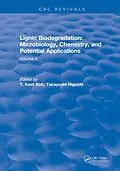Lignin is a generic name for the complex aromatic polymers that are major components of vascular plant tissues. Lignin is abundant; in terms of weight it is probably second only to cellulose among renewable organic materials, and in terms of energy content it might well be the single most abundant. an international seminar on lignin biodegradation was organized and was held May 9 to 11, 1978, at the U.S. Forest Products Laboratory in Madison, Wisconsin. This book records the proceedings of that seminar and is meant to provide a summary of research. Each speaker/author was asked to summarize his research, including his latest unpublished results, and to describe how his work fits into the overall picture. Following two orientation chapters, one a review of lignin structure and morphological distribution in plant cell walls, and the second a review of the microbial catabolism of relevant aromatics, the book is comprised of chapters in the three subject areas given by the book's title. It does, as intended, provide comprehensive coverage of research to date (August 1978).
Autorentext
T. Kent Kirk, Ph.D, received his Ph.D. in Plant Pathology and Biochemistry from North Carolina State University in 1968. After 1-1/2 years as a post doctoral researcher (organic chemistry) at Chalmers University in Sweden, he joined the staff at the U.S. Forest Service's Forest Products Laboratory in Madison, Wisconsin, where he is a Research Scientist. He holds two Adjunct Associate Professorships: Department of Bacteriology, University of Wisconsin, Madison; and Department of Wood and Paper Science, North Carolina State University, Raleigh. He serves on the Editorial Boards of Enzyme and Microbial Technology and Biotechnology Letters. He has over 50 scientific publications in the area of lignin biodegradation and the chemistry and biochemistry of wood decay and has presented numerous lectures at universities and research laboratories.
Inhalt
VOLUME II Chapter 1 Degradation of Lignin-Related Substances by Sporotrichum pulverulentum, Chapter 2 The Role of Laccase in Lignin Biodegradation , Chapter 3, Enzymatic Transformations of Lignin, Chapter 4 Studies on the Physiology of Lignin Metabolism by White-Rot Fungi, Chapter 5 Genetic and Biochemical Studies on P. chrysosporiurn and Their Relation to Lignin Degradation Chapter 6 Microbial Metabolism of Lignin-Related Aromatics , Chapter 7 Isolation and Characterization of Lignocellulose-Decomposing Actinomycetes Chapter 8 Degradation of Lignin-Related Compounds by Several Pseudomonads. Chapter 9 Metabolism of Lignin-Related Compounds by Bacteria Chapter 10 Biodegradation of Lignin-Related Polystyrenes. Chapter 11 Microbial Decolorization and Defoaming of Pulping Waste Liquors Chapter 12, Regulation and Genetics of the Biodegradation of Lignin Derivatives in Pulp Mill Effluents Chapter 13 Liznin Biodegradation and the Production of Ethyl Alcohol from Cellulose. Chapter 14 Biomechanical Pulping Chapter 15 Ultrastructural Changes in the Wall of Spruce Tracheids Degraded by Sporotrichum pulverulentum Chapter 16 Lignin Biodegradation: Summary and Perspectives
